Table of Contents
THE GLOBE THEATRE
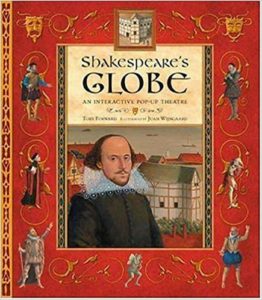
|
Shakespeare’s Globe: An Interactive Pop-Up Theatre by Toby Forward and Jan Wijngaard (Candlewick Press, 2005) is a detailed and accurate ten-inch fold-out model of the Globe Theatre, along with twelve moveable characters from the plays, a pair of abbreviated scripts, and background information on the Elizabethan theatre world. Enact your own small-sized Shakespearean plays. For ages 9-12. |
| Shakespeare’s Globe is the website of the modern rebuilt Globe Theatre. The site, along with wonderful scenes of the theatre and performances, has an extensive and excellent education section and a playground for kids with games, activities, and quizzes, hosted by a collection of Shakespeare’s Beasts. | |
 |
The Globe Theatre Model Kit is a cardstock model of the theatre with 99 parts. (Finished size: about 10 inches wide and 4 inches high.) Not for the very young. About $16. |
| At 8 Insane Literary Lego Projects, check out the incredible Lego version of Shakespeare’s Globe. |
DAILY LIVING WITH SHAKSPEARE, or Food, Football, Flowers, and Insults
| Games and Sports in Shakespeare lists every game and sport mentioned by Shakespeare, with references and explanations. They’re in alphabetical order, from Archery to Wrestling. | |

|
Jessica Kerr’s Shakespeare’s Flowers (Johnson Books, 1997) covers the lore of all the flowers mentioned in Shakespeare’s plays and poems. Illustrated with lovely full-color paintings. |
| Plant a Shakespeare garden of your own. From the New York Botanical Garden, see Shakespeare Garden for suggestions and plant lists. | |
| Want to talk like Shakespeare? See Proper Elizabethan Accents for pronunciation drills, vocabulary and grammar practice, insults and cursing (use your judgment), forms of address, and songs. Learn how to say “Good morrow” properly and what to yell at a pickpocket. | |
| Take your diction out for a spin on Talk Like Shakespeare Day, celebrated annually on April 23, Shakespeare’s birthday. | |
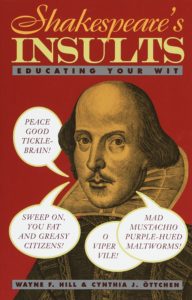
|
By Wayne F. Hill and Cynthia J. Ottchen, Shakespeare’s Insults (Three Rivers Press, 1995) is a collection of 5000, excerpted from the plays. Everything you ever wanted to know about Elizabethan invective. For teenagers and adults. |
| Shakespeare Insults Playing Cards have an insult for each illustrated card. | |
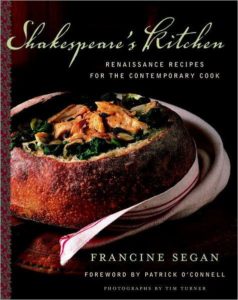
|
Francine Segan’s Shakespeare’s Kitchen (Random House, 2003) is a terrific collection of “Renaissance Recipes for the Contemporary Cook,” running from “Kickshaws” and “Pottage” to “Feasting and Bills of Fare.” The original 17th-century recipes are paired with modern interpretations, background information, and color photographs. A great source for your next Shakespearean banquet. |
| Also see To Feast or Not to Feast: Toasting the Bard’s Birthday from National Geographic’s The Plate. | |
| From TeachersFirst, find out how to throw a Shakespearean Feast. The site includes a discussion of Elizabethan table manners (no forks) and a range of Elizabethan recipes, from trifle to steak and kidney pie. |
PERFORMING SHAKESPEARE
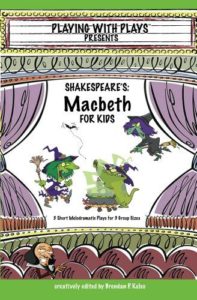
|
By Brendan P. Kelso, the Playing with Plays Series (BookSurge Publishing) consists of short (10-minute) adaptations of Shakespeare’s plays for young performers. Titles include A Midsummer Night’s Dream, The Tempest, Twelfth Night, Romeo and Juliet, Macbeth, Hamlet, Julius Caesar, and The Taming of the Shrew. Each book contains three versions of the play (for small-, medium-, and large-sized casts) with rehearsal and performance suggestions. For ages 7 and up. Also see the Playing with Plays: Shakespeare for Kids website. |
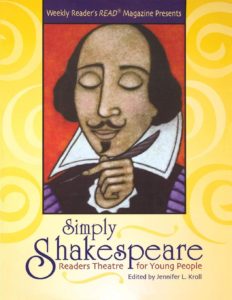
|
Edited by Jennifer Kroll, Simply Shakespeare: Readers Theatre for Young People (Libraries Unlimited, 2003) has simplified and modernized versions of 13 Shakespearean plays, with accompanying suggestions for presentations and props. For ages 10 and up. |
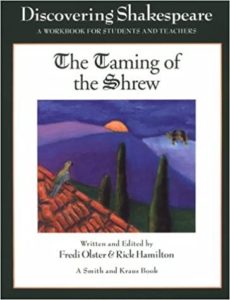
|
Truncated or modernized versions of Shakespeare can be helpful for those planning Shakespearean performances, particularly if your cast is on the younger side. The Discovering Shakespeare Series by Fredi Olster and Rick Hamilton (Smith and Kraus) are worktexts for middle- and high-school-level kids interested in Shakespearean acting. The books include both abridged and vernacular versions of the originals, plus stage directions, performance tips, and related exercises. Available for A Midsummer Night’s Dream, Macbeth, Much Ado About Nothing, The Taming of the Shrew, and Romeo and Juliet. |

|
Playwright Ken Ludwig’s How to Teach Your Children Shakespeare (Crown, 2013) as an engrossing account of how the author taught his kids Shakespeare, beginning when they were six years old. (And why teach Shakespeare? Because, says Ludwig, he’s one of the two great bedrocks of Western civilization in English, along with the King James Bible.) A great resource for parents and teachers. |
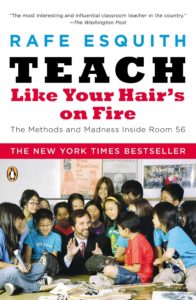
|
Rafe Esquith’s Teach Like Your Hair’s on Fire (Penguin Books, 2007) is the story of a brilliant, dedicated, and creative teacher attempting to promote a progressive and successful curriculum for his fifth-graders despite the restrictions of the school system. It’s a fascinating and inspirational book, crammed with wonderful ideas. Check out Esquith’s account of his Hobart Shakespeareans, famous for performing full-text Shakespeare plays. For parents, homeschoolers, teachers, and all interested in education. |
| See the PBS documentary on Esquith’s Shakespeare program, The Hobart Shakespeareans (2005). | |
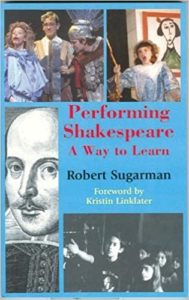
|
Robert Sugarman’s Performing Shakespeare: A Way to Learn (Mountainside Press, 2011) describes four very different (and very successful) programs for doing Shakespeare with kids. A great resource for would-be Shakespeareans. |
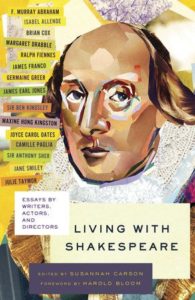
|
Edited by Susannah Carson, Living with Shakespeare (Vintage, 2013) is a collection of essays by writers, actors, and directors, sharing their personal experiences of the Bard. Among the contributors are Isabel Allende, Ralph Fiennes, James Earl Jones, Joyce Carol Oates, and Julie Taymor. For teenagers and adults. |

|
From the Unemployed Philosopher’s Guild, how about a Shakespeare finger puppet? (Put on a small play.) |
